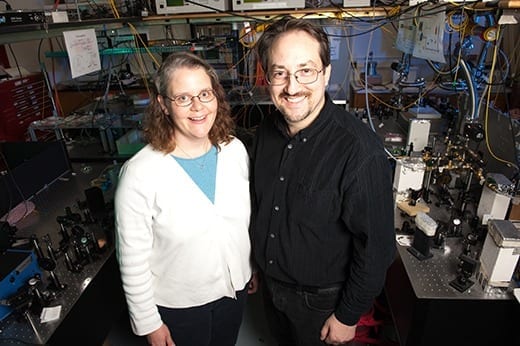
A new class of lasers developed by a team that included physics researchers at Kansas State University could help scientists measure distances to faraway targets, identify the presence of certain gases in the atmosphere and send images of the earth from space.
These energy-efficient lasers also are portable, produce light at difficult-to-reach wavelengths and have the potential to scale to high-powered versions.
The new lasers were invented by Brian Washburn and Kristan Corwin, both associate professors of physics at Kansas State University’s College of Arts & Sciences, along with Andrew Jones, a May 2012 doctoral graduate in physics, and Rajesh Kadel, a May 2014 doctoral graduate in physics. Other contributors include three University of New Mexico physics and astronomy researchers: Wolfgang Rudolf, a Regents professor and department chair, Vasudevan Nampoothiri, a research assistant professor, and Amarin Ratanavis, a doctoral student; and John Zavada, a Virginia-based optic and photonic physicist who brought them all together.
The new lasers are fiber-based and use various molecular gases to produce light. They differ from traditional glass-tube lasers, which are large and bulky, and have mirrors to reflect the light. But the novel lasers use a hollow fiber with a honeycomb structure to hold gas and to guide light. This optical fiber is filled with a molecular gas, such as hydrogen cyanide or acetylene. Another laser excites the gas and causes a molecule of the excited gas to spontaneously emit light. Other molecules in the gas quickly follow suit, which results in laser light.
“By putting the gas in a hollow core, we can have really high intensities of light without having to put such high amounts of power into the laser,” Corwin said. “If you had a glass tube of that size and put light in it, the light would escape through the sides. It’s actually the structure that makes it work.”
The structure also allows for portability. In contrast to traditional lasers, which are fragile and cumbersome to move, the researchers’ more durable fiber laser is about the thickness of a single strand of hair and can wrap around itself for compact storage and transportation.
“The smallness is nice,” Washburn said. “You can wrap up the coil like a string.”
The invention process began when Zavada brought Washburn and Corwin, who already had expertise putting gas into hollow fibers, together with Rudolph and Nampoothiri, who were skilled in making optically pumped gas lasers.
“We thought hard about how this would all work together, and after about a year and a half, we came up with this,” Corwin said.
The inventors’ lasers use gas, which was the popular method before manufacturers moved to solid-state materials. For example, up until the mid-1990s, grocery store scanners were gas lasers, while present-day grocery scanners use solid-state lasers.
“What we’ve done is use an old-school technology medium in a new-school package,” Washburn said.
Learn more: Kansas State University researchers invent, patent new class of lasers
The Latest on: Lasers
[google_news title=”” keyword=”lasers” num_posts=”10″ blurb_length=”0″ show_thumb=”left”]
via Google News
The Latest on: Lasers
- Mace, green lasers, screeching soundtracks: Inside the UCLA encampment on a night of violenceon May 1, 2024 at 7:14 pm
Even before Tuesday night's bloody physical altercations, protesters occupying a pro-Palestinian encampment at UCLA said counterdemonstrators have assaulted them nightly with a jarring barrage of ...
- Ivory-scanning lasers used to illuminate the illegal elephant in the roomon April 29, 2024 at 5:00 pm
Scientists can now use lasers to differentiate between the two materials, hopefully reducing the revenue stream for poachers. In order to protect dwindling elephant populations, the international ...
- In a first, scientists precisely control thorium nuclei with laserson April 29, 2024 at 9:18 am
For the first time, researchers employ a laser to raise an atomic nucleus's energy state, then precisely track its return to baseline.
- Chinese scientists want to use lasers to power ultrafast, stealthy submarines. A laser expert says there's a major flaw in their plan.on April 28, 2024 at 3:28 am
Chinese scientists from Harbin University say they've made a breakthrough in underwater laser propulsion technology.
- 32 times lasers revealed hidden forts and settlements from centuries agoon April 27, 2024 at 3:01 am
Lasers have helped uncover ancient human-made structures the world over. Lasers are being used extensively in archaeology for recording and discovering sites as well as analyzing artifacts in great ...
- Florida man arrested for allegedly pointing lasers at passenger aircraft at international airport: policeon April 25, 2024 at 8:55 pm
A Florida man was arrested after he allegedly pointed a laser at a Jet Blue plane that was landing at Tampa International Airport, according to police.
- Florida man arrested for pointing lasers at arriving planes: TPDon April 25, 2024 at 10:19 am
A man was arrested for pointing lasers at arriving planes in Tampa over the course of several months, according to police.
- Marjorie Taylor Greene's "space lasers" show how the GOP gets away with escalating violenceon April 22, 2024 at 3:00 am
From Kari Lake's "strap on a Glock" to the Supreme Court coddling Capitol rioters, GOP threat levels are growing ...
- Lasers, Inflatable Dancers and the Fight to Fend Off Avian Fluon April 20, 2024 at 2:01 am
Some poultry growers are turning to innovative tactics to protect their flocks, deploying deterrents like drones, air horns, balloons and decoy predators.
- Marjorie Taylor Greene Demands Anti-Immigrant Space Laserson April 19, 2024 at 11:03 am
Not a Joke Remember when Rep. Marjorie Taylor Greene (R-Ga.) came under fire for talking about her insane and anti-semitic conspiracy theory that Jewish space lasers were to blame for the devastating ...
via Bing News










